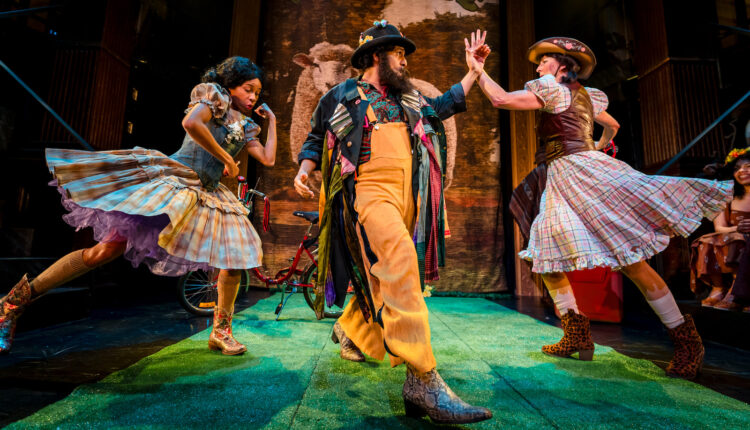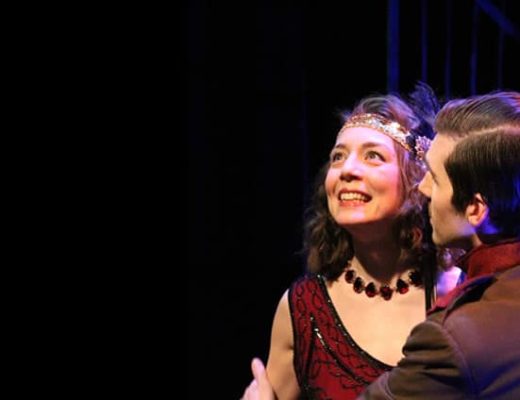By D. R. Lewis
This article was originally published in The DC Line, here.
For the unacclimated, an advertisement for William Shakespeare’s The Winter’s Tale might conjure images of holiday stories that are often seen on stage this time of year. But DC audiences will find a twisting, tangled yarn spun of jealous royals, blood-thirsty bears and folksy shepherds rather than holly sprigs and spirits of Christmases past, present and future. Playing through Dec. 17 in an admirable production, Folger Theatre reasserts The Winter’s Tale as one of Shakespeare’s “problem plays” and begs audience members to open their imaginations to the playwright’s most extraordinary dramatic whims.
The Winter’s Tale begins in the court of Sicilian king Leontes (Hadi Tabbal), who misinterprets a moment of friendship between his pregnant wife Hermione (Antoinette Crowe-Legacy) and visiting Bohemian king Polixenes (Drew Kopas). Growing jealous, Leontes instructs an aide to kill Polixenes, imprisons Hermione, and orders the abandonment of newborn child Perdita. While Polixenes manages to escape, Hermione ambiguously withers away and the baby is left to die in Bohemia. Only after the Oracle of Delphos exonerates Hermione does Leontes see the foolishness in his jealousy, prompting him to commit to atoning for his reckless behavior. Years later, Perdita (Kayleandra White) — having been rescued and raised by a shepherd — falls in love with Bohemian prince Florizel (Jonathan Del Palmer). Their love, along with the epiphany that Perdita is the Sicilian princess, not only brings the kingdoms together in friendship once again, but also facilitates Hermione’s resurrection (or, perhaps, the revelation that she’s been alive all along).
What begins as a deeply dramatic descent of a jealous king, complete with death and banishment, eventually gives way to a joyous romp of mistaken identity and inevitable romance. Such tonal transition has marked The Winter’s Tale with the scholarly “problem play” label, and presents a significant challenge for producing companies to hold the audience’s attention through the shifting vibe. Sure, for some, Shakespeare’s “genius” status leaves him immune to criticism. But The Winter’s Play is too full of dissatisfying dramatic wrinkles to make for anything other than an inconsistent night in the theater. When compared to the rest of the canon, The Winter’s Tale reveals itself as simply a lesser play. Please don’t shake your fist (spear?) at me.
Regardless, director Tamilla Woodard does her best to rise to the challenge — and by and large delivers. Rather than trying to force a smooth gradient between the play’s initial drama and the subsequent comedy, she leans on her ensemble of actors and creative team to draw stark stylistic differences between the two halves of her production. Raul Abrego Jr.’s bilevel set, which fits snugly onto the Folger’s small stage, alternates effectively between the chic, angular modernism in the play’s Sicilian scenes and the country cowboy flair of more rural Bohemia. Sarah Cubbage’s costumes correspond accordingly, with charcoal suits and businesswear for the royal Sicilians and cowboy hats and chaps for their rural Bohemian counterparts. Max Doolittle’s lighting design appropriately sets the mood, especially in the darkness of the forest where Perdita was to be abandoned and the sunny sheep-shearing festival that is the centerpiece of the production’s second half. These strong style choices effectively signal to the audience that the dramatic landscape has changed, helping to ease the emotional whiplash.
But not all of the choices are as successful. The Winter’s Tale has the distinction of owning the prototypical bloodthirsty bear, who pursues and mauls Antigonus (Stephen Patrick Martin) as he deposits the helpless Perdita in the woods. Woodard’s production opts to evoke the bear solely through lighting effects and projection, rather than with an actor in a bear costume. It came as something of a surprise that, with the bold stylization of both the serious first act and whimsical second act, the most droll element of the play was given but three flashes of light in this production. Given the ensemble’s liberal use of the middle aisle and other areas of the house to immerse the audience, the omission of the bear’s physical representation left this reviewer wondering why it went understated.
But this downplayed sequence is soon forgotten in the wake of strong performances across the cast. As Hermione, Crowe-Legacy is a stately and sincere queen, making Leontes’ rejection of her all the more baffling and heartbreaking. Kate Eastwood Norris is both entertaining as a dancing Bohemian and deeply moving as a devoted Paulina (her delivery of one of the play’s most memorable lines, “it is a heretic that makes the fire, not she which burns in it,” inspires chills). And as the mischievous Autolycus, Reza Salazar enchants the audience with call-and-response and expert delivery of the character’s extended missives.
Despite its quirks, The Winter’s Tale offers a warm welcome for audiences returning to the Folger Shakespeare Library, which has undergone significant renovations since March 2020. The building’s ground floor entrance and lobby area are done over in concrete that evokes cool modernism and the iconic Brutalism visible in parts of downtown Washington. But upon ascending to the upper level and entering into the wood and stone Tudor theater, patrons may feel instantly transported across centuries and locales from Washington to Elizabethan London — or perhaps, for the time being at least, from Sicily to Bohemia. In this new building that embraces the contrasting styles of the historical and the modern, The Winter’s Tale, with its own stark contrasts, may be just the right choice for the Folger’s fresh start.





No Comments